The Impact of Manual Handling and Family-Centered Care in Nursing
VerifiedAdded on 2023/06/05
|5
|1800
|264
Report
AI Summary
This report examines two critical aspects of nursing practice: manual handling and family-centered care. Manual handling, including lifting and transferring patients, is a necessary but potentially hazardous procedure, often leading to musculoskeletal disorders (MSDs) among nurses, particularly in aged care settings. The report highlights the importance of safe manual handling practices, risk assessment, and training to minimize physical and emotional strain on nurses, and reduce the risk of patient falls and injuries. The second module focuses on the significance of family and caregivers in patient care, emphasizing the holistic approach and the ethical considerations of patient autonomy and decision-making. Family-centered care acknowledges the crucial role of carers in supporting patients, providing expert knowledge, and facilitating communication between patients and healthcare professionals. The report emphasizes the need to involve carers in decision-making processes, recognizing their contribution to improved patient outcomes and overall healthcare quality, especially in managing patients with cognitive impairments.
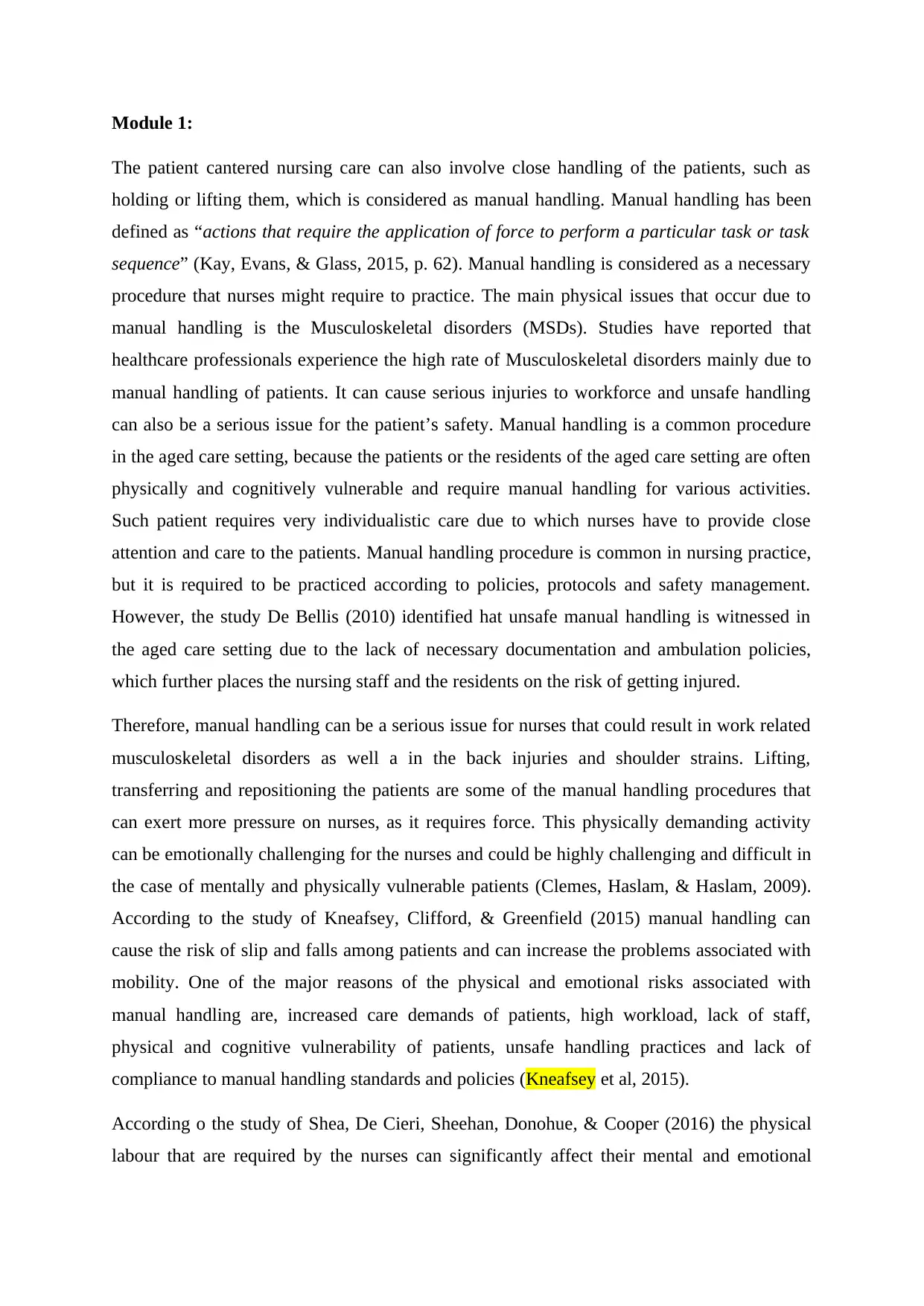
Module 1:
The patient cantered nursing care can also involve close handling of the patients, such as
holding or lifting them, which is considered as manual handling. Manual handling has been
defined as “actions that require the application of force to perform a particular task or task
sequence” (Kay, Evans, & Glass, 2015, p. 62). Manual handling is considered as a necessary
procedure that nurses might require to practice. The main physical issues that occur due to
manual handling is the Musculoskeletal disorders (MSDs). Studies have reported that
healthcare professionals experience the high rate of Musculoskeletal disorders mainly due to
manual handling of patients. It can cause serious injuries to workforce and unsafe handling
can also be a serious issue for the patient’s safety. Manual handling is a common procedure
in the aged care setting, because the patients or the residents of the aged care setting are often
physically and cognitively vulnerable and require manual handling for various activities.
Such patient requires very individualistic care due to which nurses have to provide close
attention and care to the patients. Manual handling procedure is common in nursing practice,
but it is required to be practiced according to policies, protocols and safety management.
However, the study De Bellis (2010) identified hat unsafe manual handling is witnessed in
the aged care setting due to the lack of necessary documentation and ambulation policies,
which further places the nursing staff and the residents on the risk of getting injured.
Therefore, manual handling can be a serious issue for nurses that could result in work related
musculoskeletal disorders as well a in the back injuries and shoulder strains. Lifting,
transferring and repositioning the patients are some of the manual handling procedures that
can exert more pressure on nurses, as it requires force. This physically demanding activity
can be emotionally challenging for the nurses and could be highly challenging and difficult in
the case of mentally and physically vulnerable patients (Clemes, Haslam, & Haslam, 2009).
According to the study of Kneafsey, Clifford, & Greenfield (2015) manual handling can
cause the risk of slip and falls among patients and can increase the problems associated with
mobility. One of the major reasons of the physical and emotional risks associated with
manual handling are, increased care demands of patients, high workload, lack of staff,
physical and cognitive vulnerability of patients, unsafe handling practices and lack of
compliance to manual handling standards and policies (Kneafsey et al, 2015).
According o the study of Shea, De Cieri, Sheehan, Donohue, & Cooper (2016) the physical
labour that are required by the nurses can significantly affect their mental and emotional
The patient cantered nursing care can also involve close handling of the patients, such as
holding or lifting them, which is considered as manual handling. Manual handling has been
defined as “actions that require the application of force to perform a particular task or task
sequence” (Kay, Evans, & Glass, 2015, p. 62). Manual handling is considered as a necessary
procedure that nurses might require to practice. The main physical issues that occur due to
manual handling is the Musculoskeletal disorders (MSDs). Studies have reported that
healthcare professionals experience the high rate of Musculoskeletal disorders mainly due to
manual handling of patients. It can cause serious injuries to workforce and unsafe handling
can also be a serious issue for the patient’s safety. Manual handling is a common procedure
in the aged care setting, because the patients or the residents of the aged care setting are often
physically and cognitively vulnerable and require manual handling for various activities.
Such patient requires very individualistic care due to which nurses have to provide close
attention and care to the patients. Manual handling procedure is common in nursing practice,
but it is required to be practiced according to policies, protocols and safety management.
However, the study De Bellis (2010) identified hat unsafe manual handling is witnessed in
the aged care setting due to the lack of necessary documentation and ambulation policies,
which further places the nursing staff and the residents on the risk of getting injured.
Therefore, manual handling can be a serious issue for nurses that could result in work related
musculoskeletal disorders as well a in the back injuries and shoulder strains. Lifting,
transferring and repositioning the patients are some of the manual handling procedures that
can exert more pressure on nurses, as it requires force. This physically demanding activity
can be emotionally challenging for the nurses and could be highly challenging and difficult in
the case of mentally and physically vulnerable patients (Clemes, Haslam, & Haslam, 2009).
According to the study of Kneafsey, Clifford, & Greenfield (2015) manual handling can
cause the risk of slip and falls among patients and can increase the problems associated with
mobility. One of the major reasons of the physical and emotional risks associated with
manual handling are, increased care demands of patients, high workload, lack of staff,
physical and cognitive vulnerability of patients, unsafe handling practices and lack of
compliance to manual handling standards and policies (Kneafsey et al, 2015).
According o the study of Shea, De Cieri, Sheehan, Donohue, & Cooper (2016) the physical
labour that are required by the nurses can significantly affect their mental and emotional
Paraphrase This Document
Need a fresh take? Get an instant paraphrase of this document with our AI Paraphraser
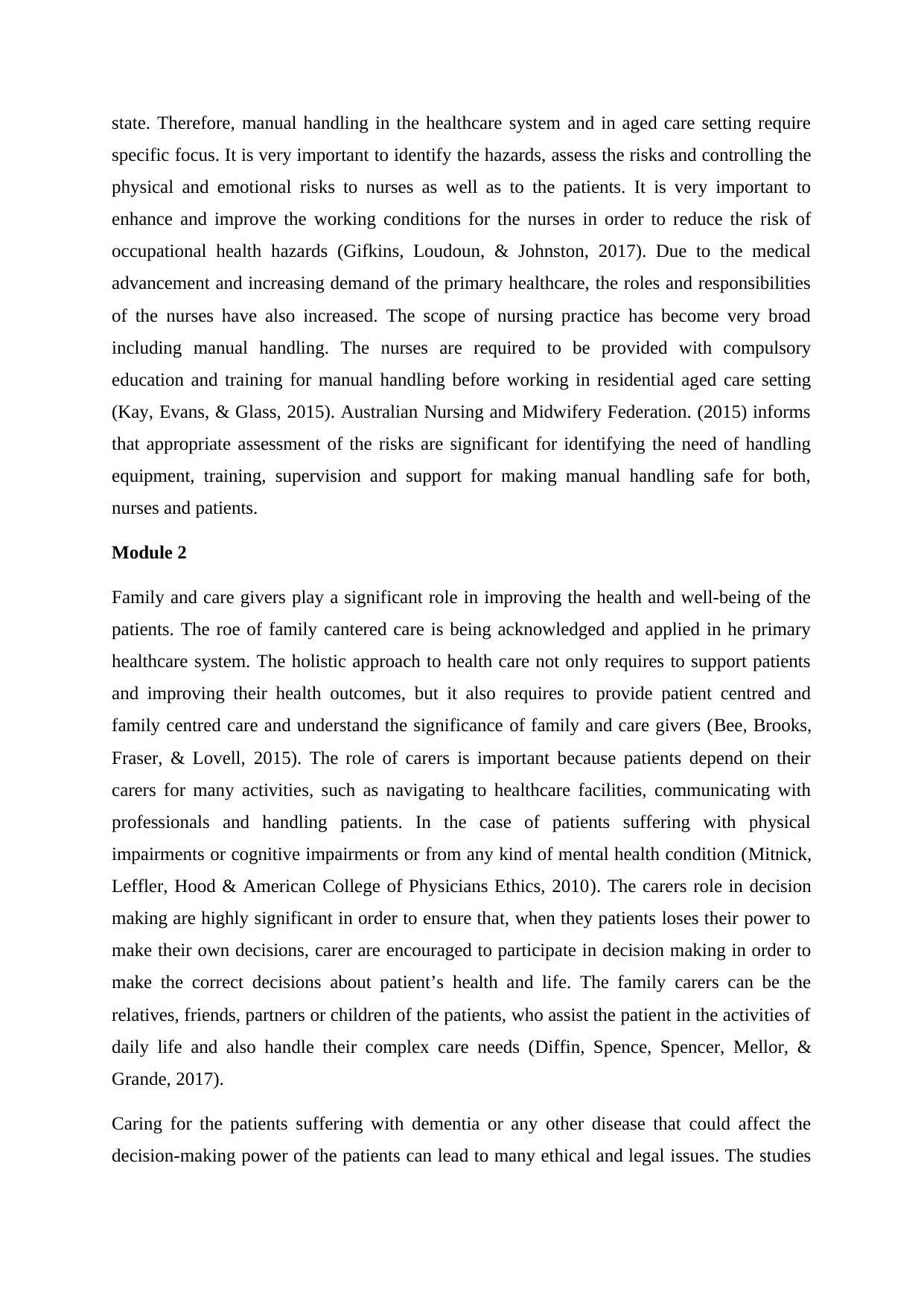
state. Therefore, manual handling in the healthcare system and in aged care setting require
specific focus. It is very important to identify the hazards, assess the risks and controlling the
physical and emotional risks to nurses as well as to the patients. It is very important to
enhance and improve the working conditions for the nurses in order to reduce the risk of
occupational health hazards (Gifkins, Loudoun, & Johnston, 2017). Due to the medical
advancement and increasing demand of the primary healthcare, the roles and responsibilities
of the nurses have also increased. The scope of nursing practice has become very broad
including manual handling. The nurses are required to be provided with compulsory
education and training for manual handling before working in residential aged care setting
(Kay, Evans, & Glass, 2015). Australian Nursing and Midwifery Federation. (2015) informs
that appropriate assessment of the risks are significant for identifying the need of handling
equipment, training, supervision and support for making manual handling safe for both,
nurses and patients.
Module 2
Family and care givers play a significant role in improving the health and well-being of the
patients. The roe of family cantered care is being acknowledged and applied in he primary
healthcare system. The holistic approach to health care not only requires to support patients
and improving their health outcomes, but it also requires to provide patient centred and
family centred care and understand the significance of family and care givers (Bee, Brooks,
Fraser, & Lovell, 2015). The role of carers is important because patients depend on their
carers for many activities, such as navigating to healthcare facilities, communicating with
professionals and handling patients. In the case of patients suffering with physical
impairments or cognitive impairments or from any kind of mental health condition (Mitnick,
Leffler, Hood & American College of Physicians Ethics, 2010). The carers role in decision
making are highly significant in order to ensure that, when they patients loses their power to
make their own decisions, carer are encouraged to participate in decision making in order to
make the correct decisions about patient’s health and life. The family carers can be the
relatives, friends, partners or children of the patients, who assist the patient in the activities of
daily life and also handle their complex care needs (Diffin, Spence, Spencer, Mellor, &
Grande, 2017).
Caring for the patients suffering with dementia or any other disease that could affect the
decision-making power of the patients can lead to many ethical and legal issues. The studies
specific focus. It is very important to identify the hazards, assess the risks and controlling the
physical and emotional risks to nurses as well as to the patients. It is very important to
enhance and improve the working conditions for the nurses in order to reduce the risk of
occupational health hazards (Gifkins, Loudoun, & Johnston, 2017). Due to the medical
advancement and increasing demand of the primary healthcare, the roles and responsibilities
of the nurses have also increased. The scope of nursing practice has become very broad
including manual handling. The nurses are required to be provided with compulsory
education and training for manual handling before working in residential aged care setting
(Kay, Evans, & Glass, 2015). Australian Nursing and Midwifery Federation. (2015) informs
that appropriate assessment of the risks are significant for identifying the need of handling
equipment, training, supervision and support for making manual handling safe for both,
nurses and patients.
Module 2
Family and care givers play a significant role in improving the health and well-being of the
patients. The roe of family cantered care is being acknowledged and applied in he primary
healthcare system. The holistic approach to health care not only requires to support patients
and improving their health outcomes, but it also requires to provide patient centred and
family centred care and understand the significance of family and care givers (Bee, Brooks,
Fraser, & Lovell, 2015). The role of carers is important because patients depend on their
carers for many activities, such as navigating to healthcare facilities, communicating with
professionals and handling patients. In the case of patients suffering with physical
impairments or cognitive impairments or from any kind of mental health condition (Mitnick,
Leffler, Hood & American College of Physicians Ethics, 2010). The carers role in decision
making are highly significant in order to ensure that, when they patients loses their power to
make their own decisions, carer are encouraged to participate in decision making in order to
make the correct decisions about patient’s health and life. The family carers can be the
relatives, friends, partners or children of the patients, who assist the patient in the activities of
daily life and also handle their complex care needs (Diffin, Spence, Spencer, Mellor, &
Grande, 2017).
Caring for the patients suffering with dementia or any other disease that could affect the
decision-making power of the patients can lead to many ethical and legal issues. The studies
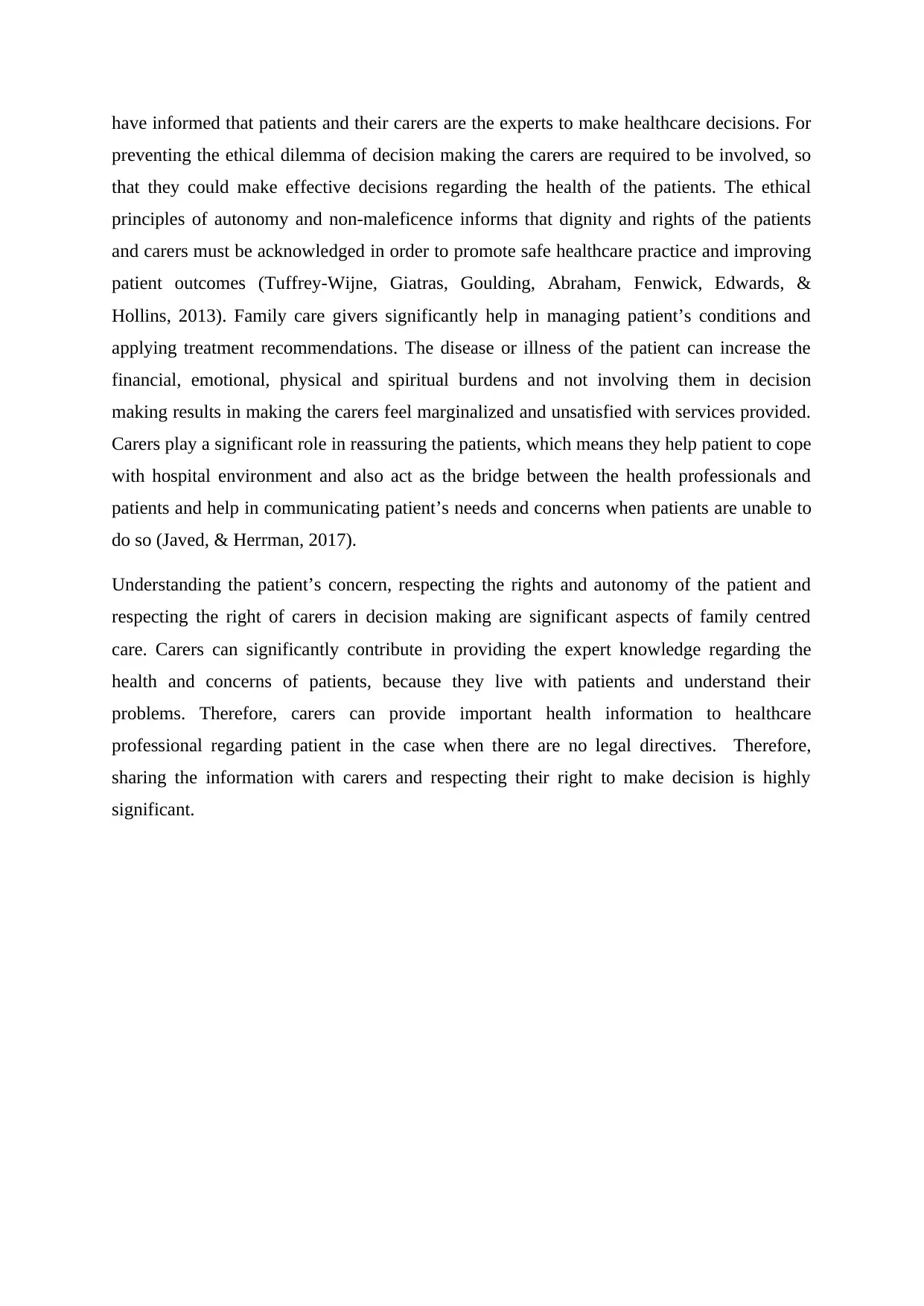
have informed that patients and their carers are the experts to make healthcare decisions. For
preventing the ethical dilemma of decision making the carers are required to be involved, so
that they could make effective decisions regarding the health of the patients. The ethical
principles of autonomy and non-maleficence informs that dignity and rights of the patients
and carers must be acknowledged in order to promote safe healthcare practice and improving
patient outcomes (Tuffrey-Wijne, Giatras, Goulding, Abraham, Fenwick, Edwards, &
Hollins, 2013). Family care givers significantly help in managing patient’s conditions and
applying treatment recommendations. The disease or illness of the patient can increase the
financial, emotional, physical and spiritual burdens and not involving them in decision
making results in making the carers feel marginalized and unsatisfied with services provided.
Carers play a significant role in reassuring the patients, which means they help patient to cope
with hospital environment and also act as the bridge between the health professionals and
patients and help in communicating patient’s needs and concerns when patients are unable to
do so (Javed, & Herrman, 2017).
Understanding the patient’s concern, respecting the rights and autonomy of the patient and
respecting the right of carers in decision making are significant aspects of family centred
care. Carers can significantly contribute in providing the expert knowledge regarding the
health and concerns of patients, because they live with patients and understand their
problems. Therefore, carers can provide important health information to healthcare
professional regarding patient in the case when there are no legal directives. Therefore,
sharing the information with carers and respecting their right to make decision is highly
significant.
preventing the ethical dilemma of decision making the carers are required to be involved, so
that they could make effective decisions regarding the health of the patients. The ethical
principles of autonomy and non-maleficence informs that dignity and rights of the patients
and carers must be acknowledged in order to promote safe healthcare practice and improving
patient outcomes (Tuffrey-Wijne, Giatras, Goulding, Abraham, Fenwick, Edwards, &
Hollins, 2013). Family care givers significantly help in managing patient’s conditions and
applying treatment recommendations. The disease or illness of the patient can increase the
financial, emotional, physical and spiritual burdens and not involving them in decision
making results in making the carers feel marginalized and unsatisfied with services provided.
Carers play a significant role in reassuring the patients, which means they help patient to cope
with hospital environment and also act as the bridge between the health professionals and
patients and help in communicating patient’s needs and concerns when patients are unable to
do so (Javed, & Herrman, 2017).
Understanding the patient’s concern, respecting the rights and autonomy of the patient and
respecting the right of carers in decision making are significant aspects of family centred
care. Carers can significantly contribute in providing the expert knowledge regarding the
health and concerns of patients, because they live with patients and understand their
problems. Therefore, carers can provide important health information to healthcare
professional regarding patient in the case when there are no legal directives. Therefore,
sharing the information with carers and respecting their right to make decision is highly
significant.
⊘ This is a preview!⊘
Do you want full access?
Subscribe today to unlock all pages.

Trusted by 1+ million students worldwide
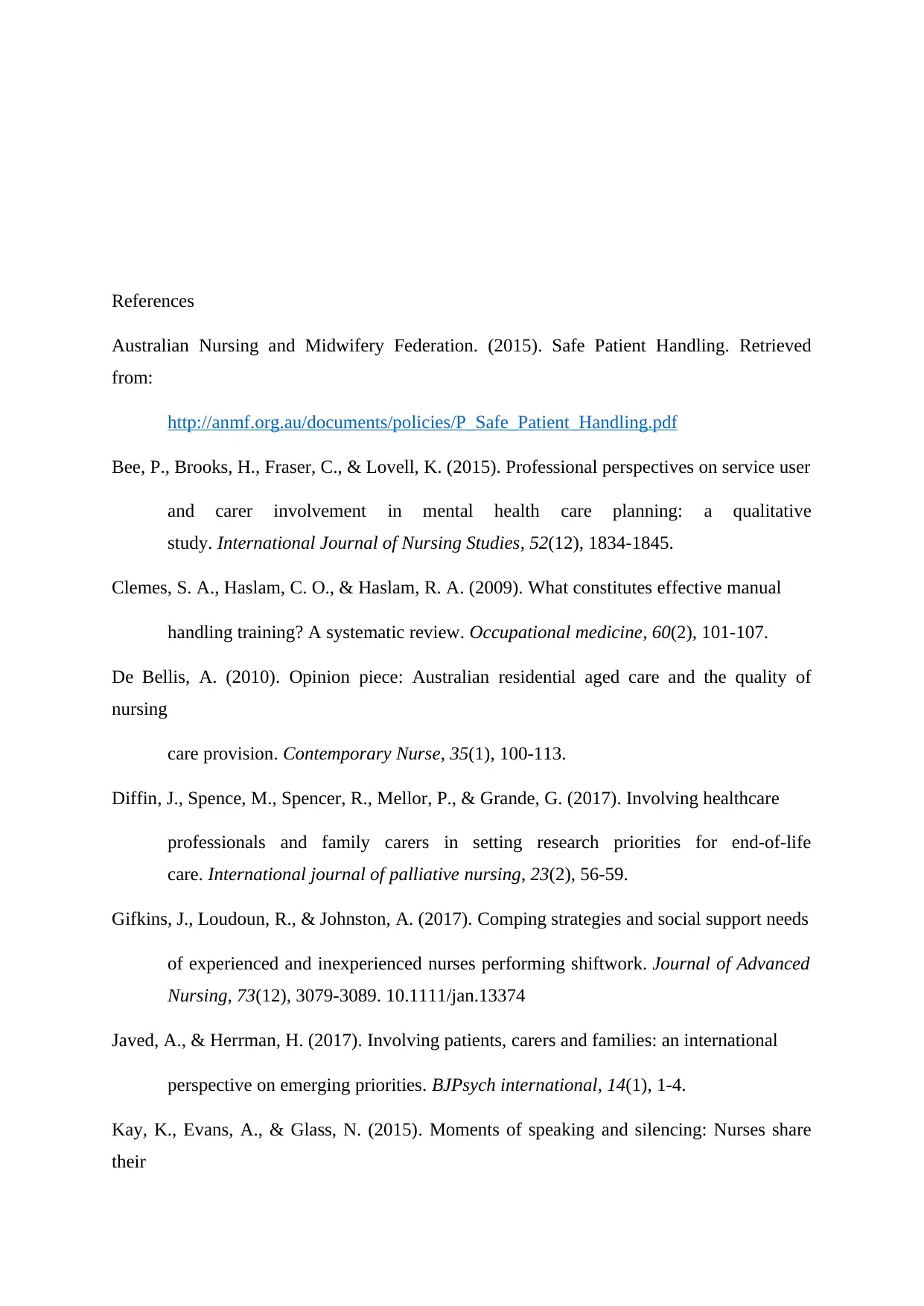
References
Australian Nursing and Midwifery Federation. (2015). Safe Patient Handling. Retrieved
from:
http://anmf.org.au/documents/policies/P_Safe_Patient_Handling.pdf
Bee, P., Brooks, H., Fraser, C., & Lovell, K. (2015). Professional perspectives on service user
and carer involvement in mental health care planning: a qualitative
study. International Journal of Nursing Studies, 52(12), 1834-1845.
Clemes, S. A., Haslam, C. O., & Haslam, R. A. (2009). What constitutes effective manual
handling training? A systematic review. Occupational medicine, 60(2), 101-107.
De Bellis, A. (2010). Opinion piece: Australian residential aged care and the quality of
nursing
care provision. Contemporary Nurse, 35(1), 100-113.
Diffin, J., Spence, M., Spencer, R., Mellor, P., & Grande, G. (2017). Involving healthcare
professionals and family carers in setting research priorities for end-of-life
care. International journal of palliative nursing, 23(2), 56-59.
Gifkins, J., Loudoun, R., & Johnston, A. (2017). Comping strategies and social support needs
of experienced and inexperienced nurses performing shiftwork. Journal of Advanced
Nursing, 73(12), 3079-3089. 10.1111/jan.13374
Javed, A., & Herrman, H. (2017). Involving patients, carers and families: an international
perspective on emerging priorities. BJPsych international, 14(1), 1-4.
Kay, K., Evans, A., & Glass, N. (2015). Moments of speaking and silencing: Nurses share
their
Australian Nursing and Midwifery Federation. (2015). Safe Patient Handling. Retrieved
from:
http://anmf.org.au/documents/policies/P_Safe_Patient_Handling.pdf
Bee, P., Brooks, H., Fraser, C., & Lovell, K. (2015). Professional perspectives on service user
and carer involvement in mental health care planning: a qualitative
study. International Journal of Nursing Studies, 52(12), 1834-1845.
Clemes, S. A., Haslam, C. O., & Haslam, R. A. (2009). What constitutes effective manual
handling training? A systematic review. Occupational medicine, 60(2), 101-107.
De Bellis, A. (2010). Opinion piece: Australian residential aged care and the quality of
nursing
care provision. Contemporary Nurse, 35(1), 100-113.
Diffin, J., Spence, M., Spencer, R., Mellor, P., & Grande, G. (2017). Involving healthcare
professionals and family carers in setting research priorities for end-of-life
care. International journal of palliative nursing, 23(2), 56-59.
Gifkins, J., Loudoun, R., & Johnston, A. (2017). Comping strategies and social support needs
of experienced and inexperienced nurses performing shiftwork. Journal of Advanced
Nursing, 73(12), 3079-3089. 10.1111/jan.13374
Javed, A., & Herrman, H. (2017). Involving patients, carers and families: an international
perspective on emerging priorities. BJPsych international, 14(1), 1-4.
Kay, K., Evans, A., & Glass, N. (2015). Moments of speaking and silencing: Nurses share
their
Paraphrase This Document
Need a fresh take? Get an instant paraphrase of this document with our AI Paraphraser
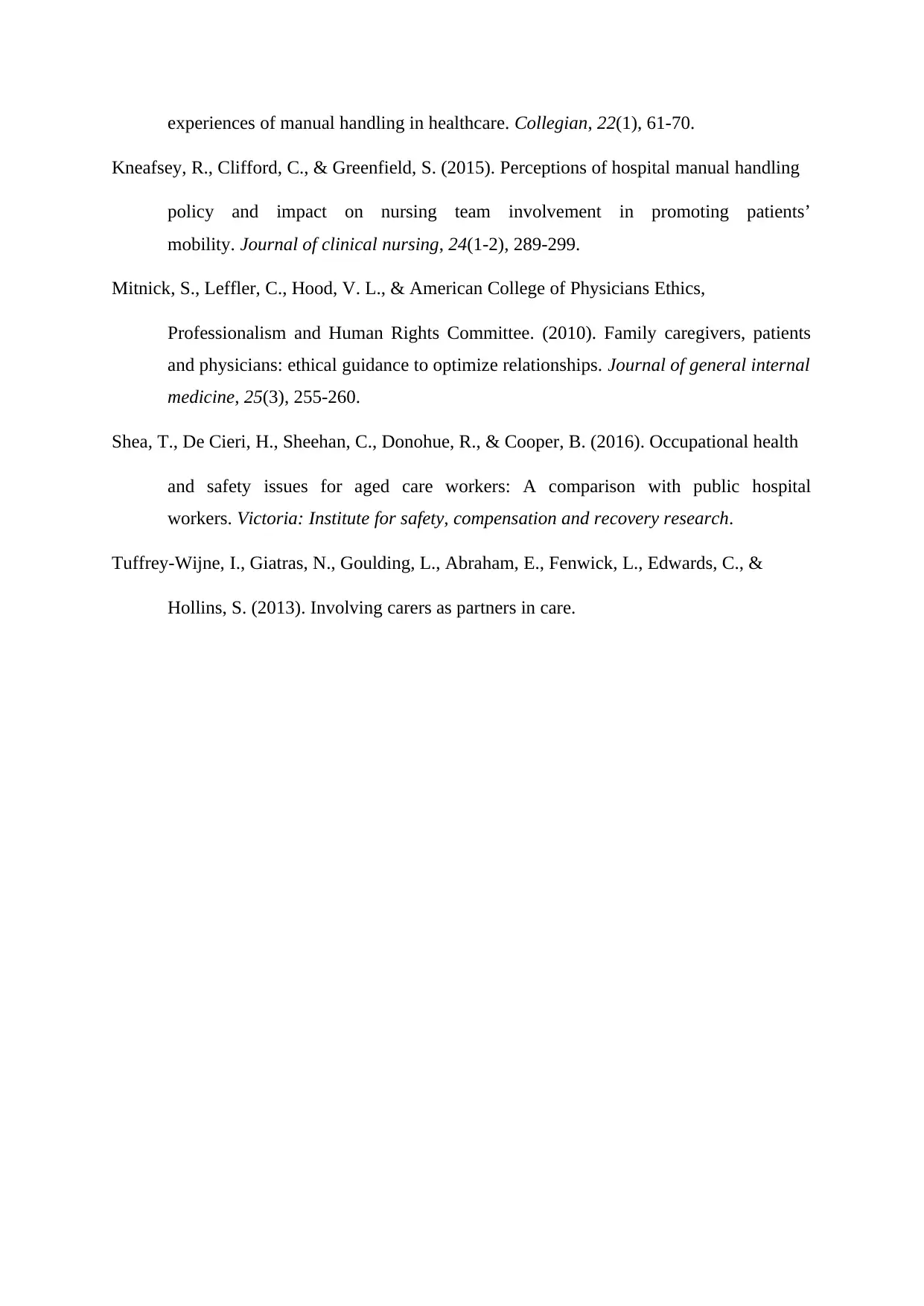
experiences of manual handling in healthcare. Collegian, 22(1), 61-70.
Kneafsey, R., Clifford, C., & Greenfield, S. (2015). Perceptions of hospital manual handling
policy and impact on nursing team involvement in promoting patients’
mobility. Journal of clinical nursing, 24(1-2), 289-299.
Mitnick, S., Leffler, C., Hood, V. L., & American College of Physicians Ethics,
Professionalism and Human Rights Committee. (2010). Family caregivers, patients
and physicians: ethical guidance to optimize relationships. Journal of general internal
medicine, 25(3), 255-260.
Shea, T., De Cieri, H., Sheehan, C., Donohue, R., & Cooper, B. (2016). Occupational health
and safety issues for aged care workers: A comparison with public hospital
workers. Victoria: Institute for safety, compensation and recovery research.
Tuffrey-Wijne, I., Giatras, N., Goulding, L., Abraham, E., Fenwick, L., Edwards, C., &
Hollins, S. (2013). Involving carers as partners in care.
Kneafsey, R., Clifford, C., & Greenfield, S. (2015). Perceptions of hospital manual handling
policy and impact on nursing team involvement in promoting patients’
mobility. Journal of clinical nursing, 24(1-2), 289-299.
Mitnick, S., Leffler, C., Hood, V. L., & American College of Physicians Ethics,
Professionalism and Human Rights Committee. (2010). Family caregivers, patients
and physicians: ethical guidance to optimize relationships. Journal of general internal
medicine, 25(3), 255-260.
Shea, T., De Cieri, H., Sheehan, C., Donohue, R., & Cooper, B. (2016). Occupational health
and safety issues for aged care workers: A comparison with public hospital
workers. Victoria: Institute for safety, compensation and recovery research.
Tuffrey-Wijne, I., Giatras, N., Goulding, L., Abraham, E., Fenwick, L., Edwards, C., &
Hollins, S. (2013). Involving carers as partners in care.
1 out of 5
Related Documents
Your All-in-One AI-Powered Toolkit for Academic Success.
+13062052269
info@desklib.com
Available 24*7 on WhatsApp / Email
![[object Object]](/_next/static/media/star-bottom.7253800d.svg)
Unlock your academic potential
Copyright © 2020–2025 A2Z Services. All Rights Reserved. Developed and managed by ZUCOL.





